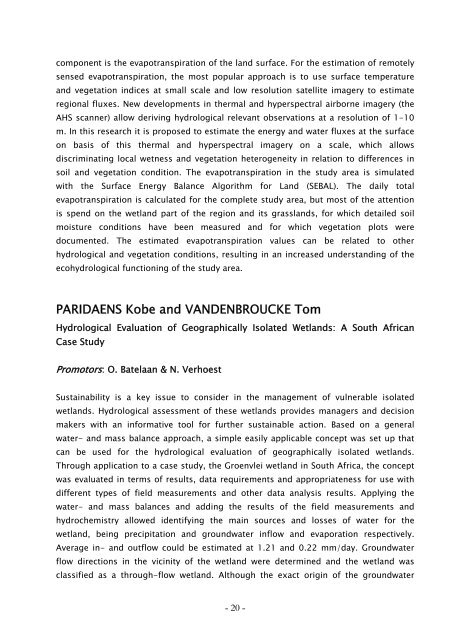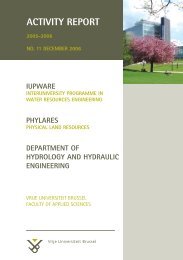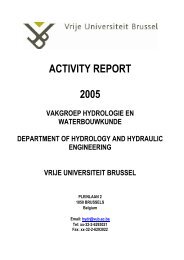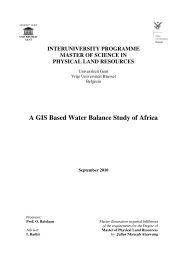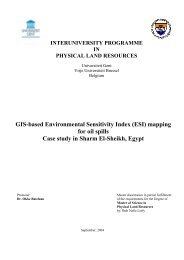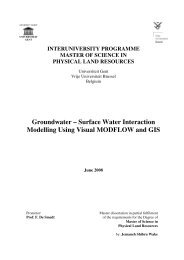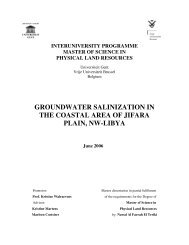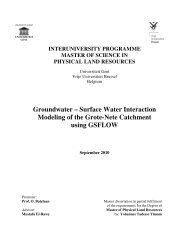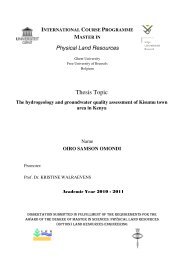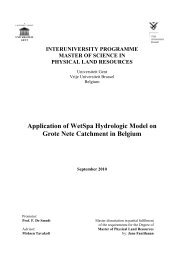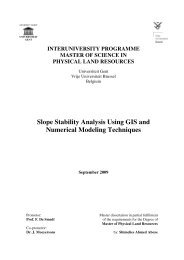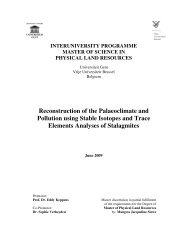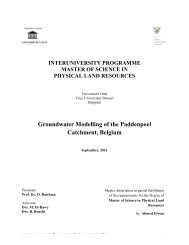C O N T E N T S - Physical Land Resources - Vrije Universiteit Brussel
C O N T E N T S - Physical Land Resources - Vrije Universiteit Brussel
C O N T E N T S - Physical Land Resources - Vrije Universiteit Brussel
You also want an ePaper? Increase the reach of your titles
YUMPU automatically turns print PDFs into web optimized ePapers that Google loves.
component is the evapotranspiration of the land surface. For the estimation of remotelysensed evapotranspiration, the most popular approach is to use surface temperatureand vegetation indices at small scale and low resolution satellite imagery to estimateregional fluxes. New developments in thermal and hyperspectral airborne imagery (theAHS scanner) allow deriving hydrological relevant observations at a resolution of 1-10m. In this research it is proposed to estimate the energy and water fluxes at the surfaceon basis of this thermal and hyperspectral imagery on a scale, which allowsdiscriminating local wetness and vegetation heterogeneity in relation to differences insoil and vegetation condition. The evapotranspiration in the study area is simulatedwith the Surface Energy Balance Algorithm for <strong>Land</strong> (SEBAL). The daily totalevapotranspiration is calculated for the complete study area, but most of the attentionis spend on the wetland part of the region and its grasslands, for which detailed soilmoisture conditions have been measured and for which vegetation plots weredocumented. The estimated evapotranspiration values can be related to otherhydrological and vegetation conditions, resulting in an increased understanding of theecohydrological functioning of the study area.PARIDAENS Kobe and VANDENBROUCKE TomHydrological Evaluation of Geographically Isolated Wetlands: A South AfricanCase StudyPromotors: O. Batelaan & N. VerhoestSustainability is a key issue to consider in the management of vulnerable isolatedwetlands. Hydrological assessment of these wetlands provides managers and decisionmakers with an informative tool for further sustainable action. Based on a generalwater- and mass balance approach, a simple easily applicable concept was set up thatcan be used for the hydrological evaluation of geographically isolated wetlands.Through application to a case study, the Groenvlei wetland in South Africa, the conceptwas evaluated in terms of results, data requirements and appropriateness for use withdifferent types of field measurements and other data analysis results. Applying thewater- and mass balances and adding the results of the field measurements andhydrochemistry allowed identifying the main sources and losses of water for thewetland, being precipitation and groundwater inflow and evaporation respectively.Average in- and outflow could be estimated at 1.21 and 0.22 mm/day. Groundwaterflow directions in the vicinity of the wetland were determined and the wetland wasclassified as a through-flow wetland. Although the exact origin of the groundwater- 20 -


